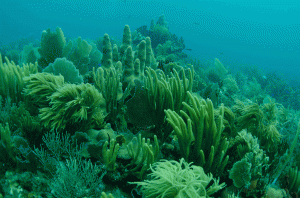CSUN Prof Investigates Why Some Corals Are Thriving During Global Warming

An underwater “animal forest” made from gorgonian soft corals off the island of St. John. Photo by Peter Edmunds
California State University, Northridge marine biology professor Peter Edmunds has spent the past 27 years documenting the health of the world’s oceans, in particular their coral and the vibrant reefs the corals create.
While his research on the devastating impact global warming and increasing ocean acidity has had on stony corals and reefs has drawn international attention to the problem, it’s his new work, studying how climate change may be helping “soft” corals thrive, that has caught the attention of the U.S. National Science Foundation.
Edmunds and his colleague, Howard Lasker, a geology professor at the University at Buffalo, received a nearly $1 million three-year grant last month from the National Science Foundation to investigate why soft corals, known as gorgonian corals—which often form a “canopy” over reefs—seem to be thriving in certain areas while their harder cousins, stony coral—which form the backbone of ocean reefs—are dying.
“It’s something we’ve been seeing for a while, but no one has ever really looked into what is happening and why,” Edmunds said.
“Global warming and ocean acidification is clearly severely impacting the world’s stony coral, and therefore negatively impacting the sea life that rely on the reefs for their homes, as well as the humans who rely on the reefs for shoreline protection, tourism and other benefits,” he said. “At the same time, it appears that global warming seems to be having a positive impact on soft corals, which appear to be proliferating in certain areas. While this may be good for the sea life that rely on the soft corals to survive, we don’t know that this means in the future or for the areas in which they are thriving.”
In addition to Edmunds and Lasker, the research team includes a post-doctoral researcher, who will be based at CSUN, and several of Edmunds’ graduate students as well as a handful of undergraduate students.
As Edmunds’ more than a quarter century of research has documented, the violent weather and coral bleaching created by global warming and increasing ocean acidity have devastated the world’s stony coral population.
However, little research has been done on the ocean’s gorgonian coral—a softer, flexible, tree-like species that can provide canopies beneath which small fish and other aquatic life can thrive. Divers and ocean researchers, including Edmunds, have noticed in recent years that “soft” coral seems to be thriving in certain parts of the Caribbean while the stony coral is dying.
Edmunds and his team will examine 27 years of photographs he has taken of the reefs off the Caribbean island of St. John to determine how gorgonian numbers have changed. The team will then travel to St. John to run field experiments, including counting the soft coral to determine how many there are now and where they are located, so researchers can monitor the condition of the region’s gorgonian coral in the years to come.
Preliminary data from Edmunds’ photographs suggests that gorgonian coral density has indeed been increasing on the shallow reefs surrounding St. John.
Using the historical data and observations from the field, the scientists hope to model how the reef—and others like it—may look decades from now as the Earth’s climate continues to change.
The team’s field studies will try to explain why the soft corals may flourish when stony corals are in decline. The experiments in the waters of St. John will look at how two or three species of soft coral fare when growing alongside different combinations and densities of stony coral and algae.
“We’re just laying the foundation now for work to be done in the future,” Edmunds said. “There are a whole lot of questions we won’t be able to answer yet, such as what this shift in sea life in the oceans means, not only in the oceans themselves, but to human life as well. This is just the start of what could be major, ongoing research for years to come. Hopefully, someone will be interested enough to fund that work.”


 experience
experience